Ecuador - Agua, Vida y Naturaleza, planting trees and vegetables species without irrigation
 The Agua, Vida y Naturaleza Project (AVNP) – Water, Life and Nature project – has been established between 2012 and 2014. The project started on January 3, 2012 in Ecuador. During this project, various vegetable and fruit trees were planted with 70% less water.
The Agua, Vida y Naturaleza Project (AVNP) – Water, Life and Nature project – has been established between 2012 and 2014. The project started on January 3, 2012 in Ecuador. During this project, various vegetable and fruit trees were planted with 70% less water.
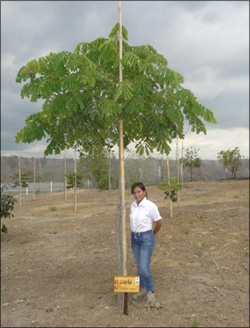 |
 |
|
Saman tree of 17 months old in Sta Elena |
The Agua Vida y Naturaleza team with Gmelina tree of 18 months old without irrigation with Groasis Ecological Water Saving Technology |
The funding of the project
The Agua, Vida y Naturaleza Project is funded by the Dutch 'COmON Foundation'. The founder of COmON has an agricultural background and supports the dream of Pieter Hoff to reforest the world with 2 billion hectares of economical and ecologically interesting trees in the coming 40 years. Through the AVNP, the founder hopes to make this possible by developing a model that can be scaled and repeated throughout the world.
The Groasis Ecological Water Saving Technology
The Groasis Ecological Water Saving Technology has been introduced by AquaPro, a private company founded by inventor Pieter Hoff. The Groasis Ecological Water Saving Technology (GT) is a biomimicry technology which restores ecosystems and vegetation cover, and consists of:
- Improving the soil with mycorrhizae;
- Leaving the soil's capillary structure intact;
- Using plants with the right primary roots;
- Using the Waterboxx® plant cocoon, and if necessary, even when planting on rocks;
- Using the capillary drill.
The Groasis Ecological Water Saving Technology is a copy of how Mother Nature solves the problem of planting plants in deserts, eroded areas, badlands and on rocks. With the Groasis Ecological Water Saving Technology, we can replant man-made deserted or eroded areas, restore the vegetation cover, and make them productive through planting fruit trees and vegetables.
Obstacles for the people who live below the poverty-line
Everyone who wants to plant in dry or eroded areas can use the Groasis Ecological Water Saving Technology. This can be governments, NGO's, investors or farmers. The AVNP focuses on farmers who are living in dry areas and have great obstacles if they want to start growing:
- Almost no access to sufficient fresh water to grow their crops;
- No capital to invest even if they want to, and;
- Little or no knowledge of how to grow high-productivity crops.
Economic Basis
There are approximately 300 million small farmers in the world; and each year there are even fewer of them left. Due to a lack of income and the prospect of a bleak future, they stop growing and move to the city. In 2009, for the first time more than 50% of the population of the world lived in cities; this is a very challenging development. In 2050, we will have approximately 10 billion people living on earth (compared to the 7 billion we just passed). We must raise our food production by at least 43% to have the same amount of food for the 10 billion as we have now for the current population of 7 billion.
Almost 1 billion people now suffer from hunger; and the price for basic food (rice, corn, wheat) have doubled over the last 3 years. It is clear that we must find a solution to this problem. This means that we have to create ways for poor farmers to produce more food and produce it more profitably! If we can do that, these farmers will stay on the land and not move to already overcrowded cities.
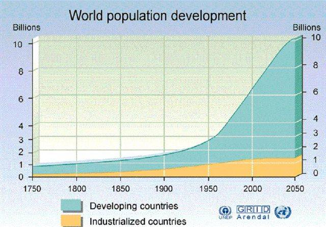
The challenge of planting trees in dry areas (like Ecuador)
Dry areas offer us opportunities, but also challenges. Many dry areas do have sufficient rain (from 250 - 500 mm or 2.5 - 5 million liters per hectare), but this rain falls very unequally during the year. The map below shows (in yellow, orange and red) all areas that have been deforested by mankind over the last 2,000 years, but that have a sufficient quantity of water to be productive. The area is approximately 2 billion hectares. These areas were once covered by trees, so if we want to, we can cover these areas again with trees. The fact that they grew there means that there is no doubt that they can grow there again. There is sufficient water for them to grow there and be productive.
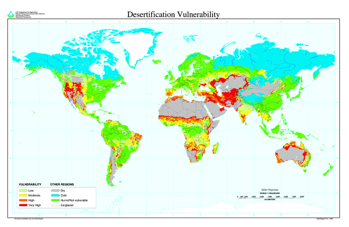
However, although there is sufficient water over the year, there is a challenge: this water falls inconsistently. There can be one or two weeks of rain, and then it is dry for 50 weeks. This means that crops depending on sowing seed (e.g. corn, outside vegetables, wheat) cannot grow there without irrigation. But there is not sufficient groundwater to irrigate the whole world. Many countries that have used too much of it in the past now already depend on reverse-osmosis technologies to produce fresh water from sewage water, or even from salted sea water (e.g. Israel, Jordan, the Middle East). Some countries have already lost once large and productive areas (e.g. Death Valley in California). In dry areas with sufficient but inconsistent water, we have to use trees to produce food. These trees have the capacity to grow there without any problem once they survive the first year - and that is exactly what the Groasis Ecological Water Saving Technology does.
The following picture shows an Acacia in North Kenya. The picture was taken during the great drought in Summer 2011. Everything below the tree is dry and dead; however, the tree is 20 meters high with a canopy 30 meters in diameter - and it is growing well. So trees that are able to overcome dry periods without rain and which produce 5 tons of fruit per hectare, are the answer to the food challenge.
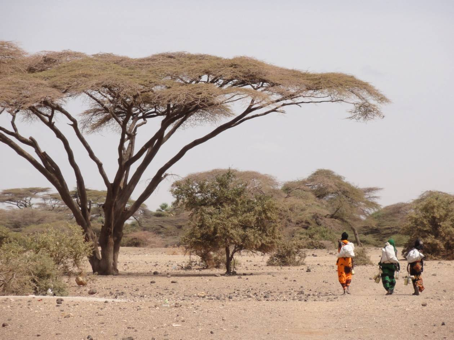
To solve the world's food shortgage problem, we have to plant a significant portion of the available 2 billions of hectares of this marginal land (i.e. eroded, degraded, rocky, arid, etc.) with trees producing food.
Who is going to plant trees in Ecuador and the rest of the world?
The next question: who is going to plant these trees in Ecuador and the rest of the world? In principle, farmers already living in those areas could do this. But they are poor and hardly have sufficient income to live. That is why so many of them stop. And planting trees means extra challenges to them - e.g. Who is going to buy and finance them? In the first five to seven years, they are not productive, but still they do require maintenance. Who is going to pay for this? How will they overcome these seven years of no income? Where do they find the food that is already so expensive - to survive on?
The answer lies in developing a short-term, cash crop income. We have to develop a way for them to produce enough food that guarantees them food for themselves, income to live from, money to invest in planting and maintaining the fruit trees, which allows them to overcome the period of five to seven years until these trees start to be productive. The best cash crop to do this is vegetables.
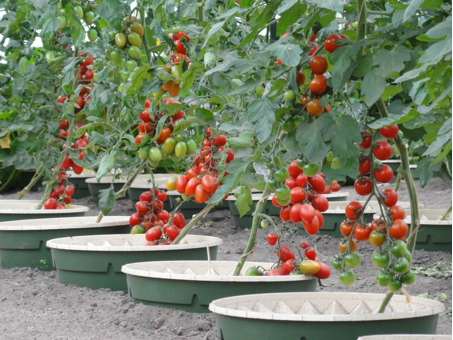 The objective is to produce 50 kilos of tomatoes per m2 with less than 20% of the average water use
The objective is to produce 50 kilos of tomatoes per m2 with less than 20% of the average water use
Can vegetables overcome 50 weeks of drought?
No, they can't. Vegetables need daily and sufficient water to grow and produce their fruits. A tomato plant that produces 1 kilo of tomatoes per week, needs significant and consistent water to do that. This is why we have started trials with the Groasis Ecological Water Saving Technology (GT) - to find out whether the technology is as effective with vegetables as it is with trees. Trials during 2011 have taught us that the GT looks promising. In the initial trials with vegetables (with water usage less than 20% compared to traditional growing techniques), we produced high levels of fruit production. To see these results, see the pictures of the various projects that show that it is possible to plant with less water or watch the various videos of multiple projects that were done with the Groasis Ecological Water Saving Technology.
What do vegetables need to survive?
Compared to trees, vegetables have other demands besides water. Trees have developed mechanisms to overcome long periods of drought. They have for instance, taproots up to 80 meter deep which can find capillary water. They also drop their leaves when the quantity of evaporation of the leaves is higher than the quantity of water that the taproots find. And cold desert nights do not damage their growth. Vegetables do not have these coping mechanisms.
We need to develop controlled environments to avoid extreme circumstances which harm vegetable production in these conditions. For this objective, we use a greenhouse in combination with a shade house. The Groasis Climate Control House (GCCH) allows us to keep the humidity high enough during the day, and keep temperatures high enough during the night. However, a plastic greenhouse causes too-high temperatures inside during the day; to avoid that extreme, we use a new kind of shading - "white shading" on top of the black shading. We use a double shade cloth. Instead of only black shading (used in 99% of situations), the extra white shading keeps out the solar radiation. We also put the shading 2 meters above the greenhouse, so that a draft can transport the heat away before it enters the greenhouse. This shading principle keeps the heat out during the day allowing us to have balanced temperatures to grow vegetables without climate stress. Together with the Waterboxx® plant cocoon which gives the plants their daily water requirement dose, we expect this technology to be capable of growing vegetables in dry areas.
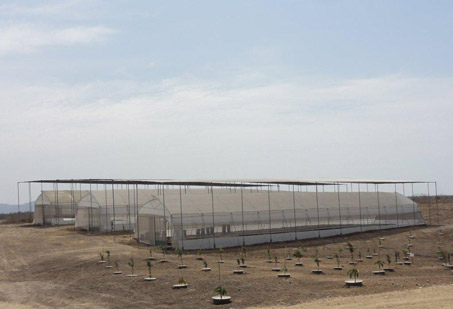
The Groasis Climate Control House has 2 shades lying on each other. They are approximately 1,50 meter above the highest point of the greenhouse. The topshade is white '65% shade' and the undershade is black '50% shade'. You can see the white topshade from this angle.
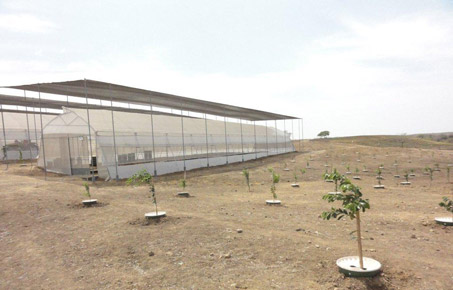
On this photo you can see the open sides. We can roll up the side plastic to an opening of 3 meters.
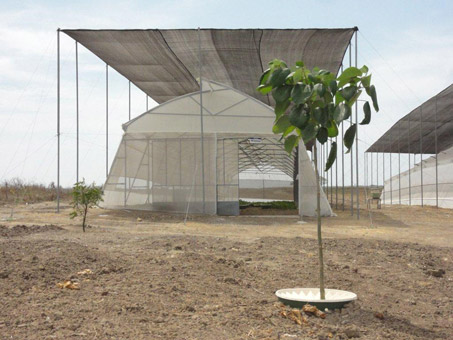
The greenhouse is 7 meters wide, the shade cloth is 10 meters wide. On each side it is 1,50 meters wider than the greenhouse. This way it also gives shade in the morning and afternoon when the sun is not on its highest point yet.
The results of growing vegetables in the greenhouses in Ecuador
The results are surprising. We are able to have lower temperatures than outside without using energy. We also have a better 'climate' with less extreme Relative Humidity differences. Further on the radiation within the greenhouse is considerably lower. You can find the results below.
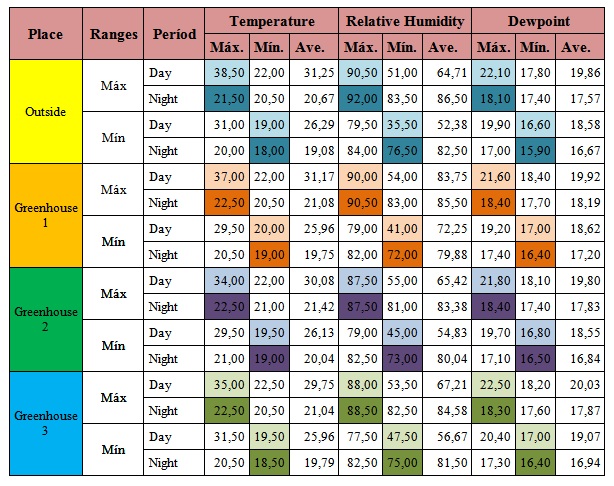
Read the results here of the succesfull plantings of the fruits and timber trees. Read the results here of the planted trees in La Chocolatera in Ecuador, which is one of the hardest places on earth to plant a tree.
Food and income
By assisting poor farmers to produce vegetables, we create a possibility for them to have sufficient sound food and sufficient income. This allows them to plant fruit trees in Ecuador and wait the five to seven years until they are productive. By developing a business model that helps poor farmers to make money, they will stop emigrating, start producing more food, and help us reforest the world with productive trees.
If we can create an army of 300 million farmers to start planting trees, then the 2 billion hectares of once forested land, will be productive again within 2 generations.
Agua, Vida y Naturaleza is a model to guarantee sufficient food and income for the farmers. The model can be copied and adapted to any situation, and then multiplied around the world.
Multiplying model based on supply of education followed by access to capital
However, the problem for these farmers is that they need education and capital to start this model. Therefore, we have focused on a training and a capital-facilitating model, which gives them the opportunity to start. If we give them access to capital after they have followed the training courses, then we are sure that they understand the technology, that they are able to make money with it, and that they have food and sufficient income to pay back their loans. Once this model works, we can multiply it to the 300 million poor farmers.
Ecuador as an example to plant trees and grow vegetables
The Guayaquil based 'Cooperativa de Ahorro y Credito' is an ideal partner to organize an Agua, Vida y Naturaleza Project. They have over 54,000 farmer-members, and 56 agricultural centers. The 56 outlets will be the future training centers for the members of the Cooperativa. The central training facility will be in the Santa Elena province of Ecuador on the experimental site of the Universidad de la Peninsula de Santa Elena, the second partner in the project. The third partner in the project is Groasis Ecuador, AquaPro's local distributor. Groasis Ecuador is founded by two entrepreneurial families with agricultural roots: the Sansur family using a company that supplies the agricultural sector; and the Nevado family using the largest and only organic rose growing company in Ecuador. The fourth partner and initiator of the project is AquaPro Holland.
Entrance to training for the farmers
The Agua, Vida y Naturaleza Project in Ecuador works according to a simple multiplication model through the following steps:
- We search for a reliable partner of which our target group are members. In this case, the Cooperativa de Credito y Ahorro (CCA), a farmers' cooperative based in Guayaquil, is the partner. If you are interested in developing a similar partner-model with us, the partner can be any effective group - e.g. a tribe, a village or a region - as long as the group has a strong organizational structure;
- We also prefer to have a scientifically strong partner – including experienced in educating students. In this case, it is the Universidad de la Peninsula de Santa Elena (UPSE)
- The scientific partner develops a training center for trainees;
- After having received training, the trainees will go to locations where poor farmers live;
- There, the Cooperative starts training centers, a copy of the training center at the University; and there, the former "trainees" become "trainers" and start to train the farmers - the women, men and if they want, their children. CCA, partner in the AVNP, has 56 outlets; it is our objective to have a training center at each outlet within 10 years.
- The training is both theoretical and practical;
- After one year, the students are offered a chance to take an exam and get - if they pass it successfully - a Groasis Ecological Water Saving Technology certificate.
Access to capital for the farmers
After having passed the exam, the farmer (or a group of farmers), can apply for capital. For this, we are looking for banks who are willing to participate. In this proposal, we have two potential capital partners. Our cooperative partner in Ecuador is facilitated by the Ecuadorian government to supply capital. In January 2012, we also had a first meeting with a strong international private bank who is very interested in investigating the model with the possibility of participating. However, there is a risky side to this kind of agricultural production that banks do not like. The farmer, although having a Groasis Certificate, mostly does not have enough collateral. For this reason, we have sought help from the Inter-American Development Bank in Washington (AIDB). We have invited AIDB to investigate the possibility of developing a model where they can play the role of guarantor for the capital supplier. In this way, AIDB can leverage its capital to a far greater extent than they now can. AIBD has shown interest and is following the Agua, Vida y Naturaleza Project. Once this financial model is successful, we have found our way of multiplying the model to the 300 million farmers worldwide.
Background information about the area
This proposal is a plan to reforest and restore the ecosystem of the Santa Elena Peninsula, Manabí, El Oro, Los Ríos, Bolivar, Guayas and Tungurahua in Ecuador. By helping farmers produce enough food and income, they are then able to plant economically important fruit trees - and eventually other environmentally important trees. This and surrounding areas have been hit by severe droughts that have led to hunger, poverty and economic collapse of the region. Instead of describing the situation here, we kindly ask you to read the following links. They will give an insight into the problems that this region and similar regions are encountering:
Reforestation in Ecuadors dry forests

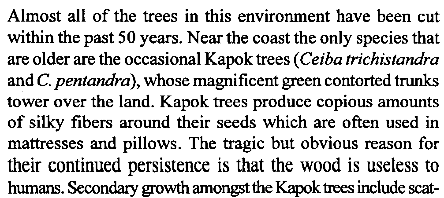
European commission (drought disasters in Ecuador – March 2011) and the drought in Ecuador causes economic losses.
Drought caused by the lack of rain in the coastal region, has caused heavy losses in agricultural production of more than $220 million. About 78,000 hectares of rice and some 110,000 hectares of corn have been lost, according to studies by the Ministry of Agriculture, Livestock, Aquaculture and Fisheries (MAGAP) and the National Secretariat of Risk.
Five provinces in the region were declared in a "state of emergency", according to Emergency Operations Center of Ecuador (COE). The worst affected provinces are Guayas and Los Ríos (90% damage). In Santa Elena, El Oro, and Manabi have dessicated around 15,000 hectares of rice, according to early reports ($156 million losses in rice production alone).
On the other hand, the Government decided to suspend exports to Colombia that was ready to buy some 150,000 tons this year. This measure will prevent domestic shortages - 90,000 tons are stored in the National Storage Unit; and 50,000 tons are in the hands of industry-by-sector authorities, which is used to meet domestic demand.
A similar crisis hit the corn growers of these areas. The costal cities in crisis lost about 110,000 hectares. Corn growers have lost about $71 million at a rate of $13 per quintal. The drought could end up taking another 100,000 hectares of maize.
Visit our training center
The GT training center will be on Santa Elena peninsula - a 1 hour drive from Guayaquil. Five times per week, there is a direct flight from Amsterdam to Guayaquil. Guayaquil is a city of approximately 2.4 million people with sufficient modern, world-class hotel facilities. Look here for info. The Agua, Vida y Naturaleza Project is open for daily visits, by appointment. For an appointment, please contact the local Project Director Ms Monica Figueroa Suarez, email This email address is being protected from spambots. You need JavaScript enabled to view it..
Start your own project and help farmers out of poverty!
We hope that this explanation of the Agua, Vida y Naturaleza Project will inspire you to also develop such a project. This project is based on developing a self-multiplying model using sound economic principles. This project is an important part of our effort to reforest the 2 billion hectares of once-forested areas with economically and ecologically interesting trees in the coming 40 years.

If you want to have the above text, you can download the next document: Explanation of objectives of Agua Naturaleza y Vida Project in Ecuador 2012-2014. If you want to organize such a project with AquaPro, this document will give you detailed background information: Figures and time table Agua Naturaleza y Vida Project 2012-2014.















